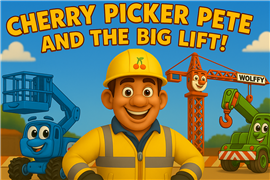What is the difference between abrasion and cut protection?
16 October 2023
Not using sling protection is a common rigging problem for all types of lifting slings – whether they are synthetic, wire rope, wire mesh or alloy chain. These slings need to be protected against edges, corners and protrusions to extend the sling’s life and prevent catastrophic failure.
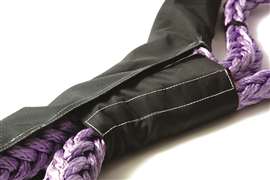 When choosing sling protection, it is critical to understand that some sling protection is good for resistance to abrasion, while other protection is good for resistance to abrasion and cutting.
When choosing sling protection, it is critical to understand that some sling protection is good for resistance to abrasion, while other protection is good for resistance to abrasion and cutting.
ITI Field Services Mike Parnell, who is ITI co-founder and senior consultant, explained that rigging accidents can often be traced back to the failure to use sling protection. Investigations found that of eight fatalities over a three-year period, the riggers selected the right type and capacity of sling for the application, but damage from cutting or friction resulted in sling failure.
Unfortunately, there is not a one-size-fits-all solution to protecting slings. This process of determining the right sling or cut protection requires heightened diligence by users.
Always use sling protection. While OSHA 1926.251(c)(9) and ASME B30.9 require synthetic slings to be protected, it is not mandatory for other types of slings. However, Mazzella’s policy is that all types of slings be protected. Here’s why.
Steel as well as synthetic slings can be damaged by rough, ribbed or uneven surfaces through abrasion. Abrasion can remove material or cause a weakening or failure of the sling. Heat from friction can cause additional damage to the sling, or could even damage the load. Even with an edge that may not seem sharp, slings can fail due to repeated exposure to an edge over time, load movement and sling pressure.
Added protection
While all slings benefit from cut and abrasion protection, it is most common to see sling protection products being used with synthetic round or web slings because they are more susceptible to cutting than wire rope or chain. To put it simply, synthetic slings virtually always require added protection. However, even wire rope becomes fatigued and wires broken when the rope bends around the load.
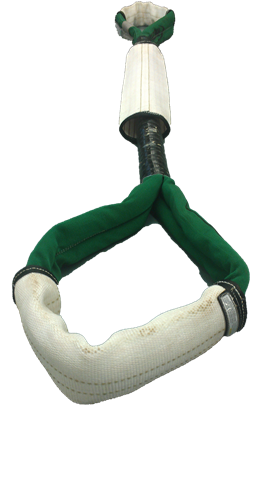 A variety of manufacturers offer corner pads, wear pads, covers or sleeves or reinforced lifting eyes that are designed to stand up to the needs of the lift, the surface of the load and the operating environment.
A variety of manufacturers offer corner pads, wear pads, covers or sleeves or reinforced lifting eyes that are designed to stand up to the needs of the lift, the surface of the load and the operating environment.
If users are looking for references, First Sling’s Linda Townsend advised, “ASME has published a Non-mandatory Appendix A on Sling Protection, included in the 2021 revision of B30.9 standard. In addition, the Web Sling and Tie Down Association provides recommendations in WSTDA-WS-2.”
WSTDA recommends that a qualified person select and use appropriately engineered protectors/softeners using either commercially available products specifically designed to protect slings from damage or by having a qualified person design and construct custom protection.
“Slings should be rigged to avoid sliding of the load through the rigging or sliding of slings across surfaces,” Parnell said. “Riggers should provide sling protection to avoid damage to slings at all times. Synthetic rigging is especially susceptible to cutting, crushing and friction damage.”
In fact, loads themselves sometimes need to be protected from the slings, especially if the surface is polished or highly finished. When any sling makes direct contact with load, it can result in scratches, crushing, dents or damage to the load. This often happens when the sling is rigged in a choker or basket hitch.
Types of sling protection
The days of using rags, cardboard, leather pieces or firehose should be gone. These materials are not intended for use as a protection device, and a properly trained and qualified rigger would know that these materials have not been evaluated for this type of use.
Instead, a variety of manufacturers offer corner pads, wear pads, covers or sleeves or reinforced lifting eyes that are designed to stand up to the needs of the lift, the surface of the load and the operating environment. Mazzella partners with many of the leading innovators in the industry to offer sling protection products like DICA’s LiftGuard, the Slingmax CornerMax products and Synthetic Armor products and Cortland’s various lines of synthetic rope protection products.
When choosing sling protection, it is critical to understand that some sling protection is good for resistance to abrasion, while other protection is good for resistance to abrasion and cutting.
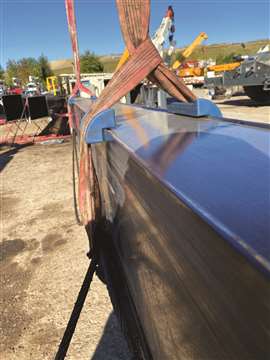 Unlike slings, standards for the design and inspection of sling protection products do not currently exist.
Unlike slings, standards for the design and inspection of sling protection products do not currently exist.
Wear pads act as a buffer between the load and the sling along the points of contact, while a sleeve wraps completely around the sling, creating a “tunnel” of protection between the sling and the edges of a load. However, true cut protection can only be accomplished by eliminating the corner or edge. Note that a corner or edge does not have to be considered “sharp” in order to cause a sling to be damaged.
DICA’s LiftGuard is different because it provides a new surface that is smooth and rounded that goes between the load and the sling, eliminating the edge or corner, instead of providing padding or extra layers of wear protection. LiftGuard Corner, Plate & Beam and Steel Coil protectors provide cut protection. Maximum capacity is achieved when the protectors are in full contact with the load, and the sling is in full contact with LiftGuard.
Medium and heavy duty LiftGuard corner protectors are designed for use with 90-degree corners. Beam and plate models are designed for use with horizontal edges such as I-beams, and the groove must fit snug on all three interior surfaces of the plate or beam. Units designed for lifting coils of steel feature a convex surface and are designed to be used inside the bore or center of a steel coil.
Refer to usage criteria
Unlike slings, standards for the design and inspection of sling protection products do not currently exist. Users should refer to manufacturer guidelines for usage criteria and inspection of sling protection products.
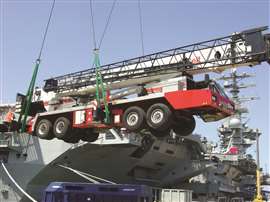 Steel and synthetic slings can be damaged by rough, ribbed or uneven surfaces through abrasion.
Steel and synthetic slings can be damaged by rough, ribbed or uneven surfaces through abrasion.
“The issue is not being ignored by standards groups,” said First Sling’s Townsend, who is a member of the ASME B30.9 Committee. “There is a need to educate the public on the difference between abrasion protection and cut protection. I anticipate that future revisions of the standard will include information on wear protection. Among the items I hope will be addressed are standards for identifying size and load ratings and whether the sling protection provides cut or abrasion protection.”
Because there’s a difference between abrasion-resistant protection and cut-resistant protection, be sure to identify the type of sling protection that is the best fit for the application.
Riggers should be trained to understand and recognize the damage potential to the sling in the application, considering the type of sling, rigging method and sling angles and physical attributes of the load, including its weight, shape and profile and materials. A qualified person, the sling manufacturer, or the sling protection manufacturer can all be involved in determining suitable sling protection for each lifting application.
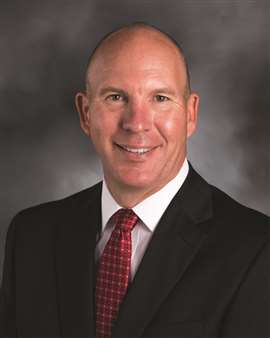 Kris Koberg
Kris Koberg
 Mike Close
Mike Close
THE AUTHORS
Kris Koberg is CEO of DICA, which builds engineered outrigger pads and sling and ground protection products. Mike Close is marketing and communications manager of Mazzella Companies, a manufacturer and distributor of products in the overhead lifting and rigging industries.
STAY CONNECTED


Receive the information you need when you need it through our world-leading magazines, newsletters and daily briefings.
CONNECT WITH THE TEAM












